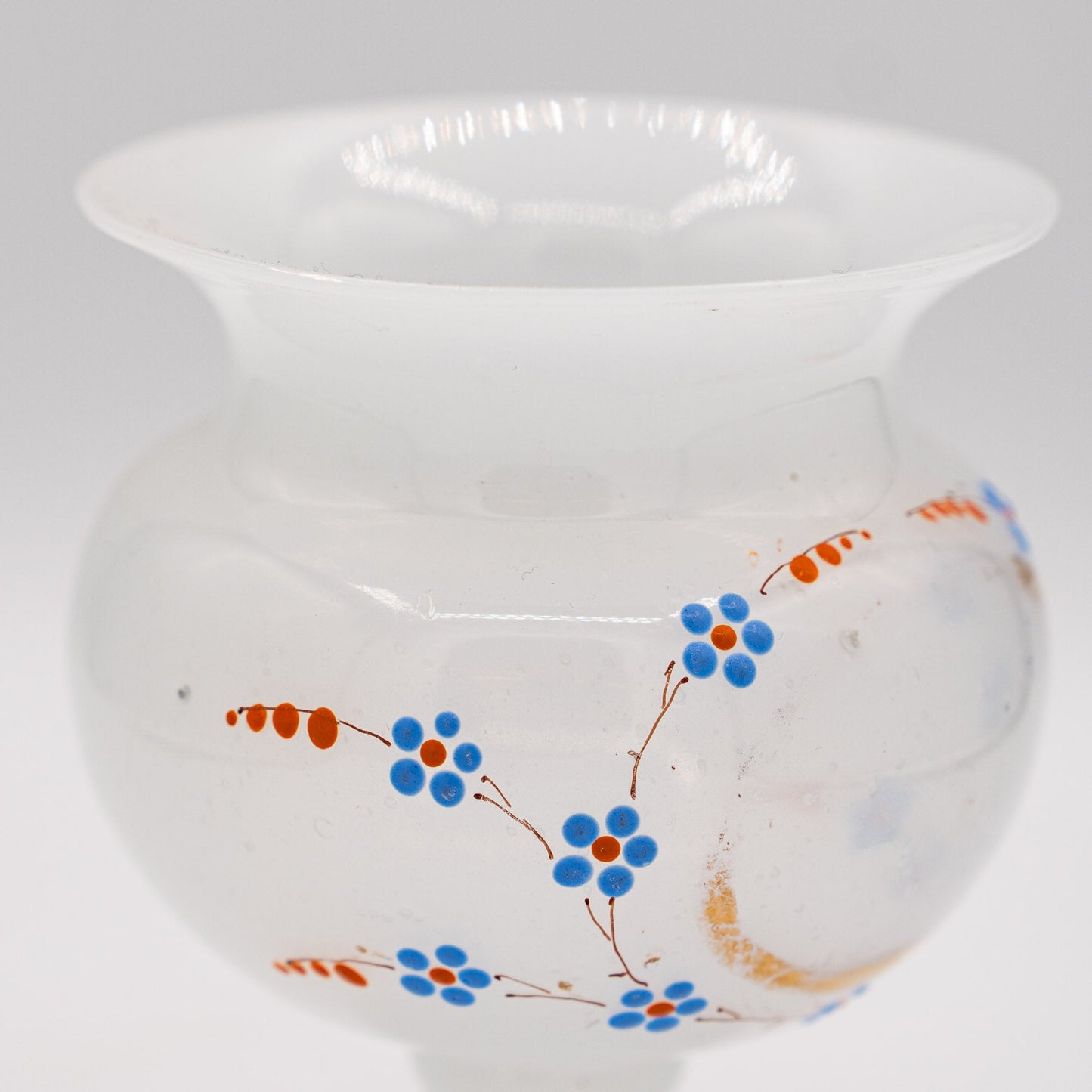The Vintage Tales
French Milk Glass Posy Vase - Forget-me-nots - 1880s
French Milk Glass Posy Vase - Forget-me-nots - 1880s
Couldn't load pickup availability
A tiny treasure from late-19th-century France: this hand-blown opaline (milk glass) posy vase is delicately enamelled with garlands of sky-blue forget-me-nots and tiny russet berries.
Petite in scale and sweet in spirit, it’s the perfect size for a few garden stems, a bedside sprig of lavender, or to brighten a shelf with a dash of Belle Époque charm.
Opaline became a favourite in the mid- to late-1800s for its soft, luminous body and elegant shapes. This example sits on a rounded pedestal foot with a bulbous body and gently flared lip. The hand-painted enamel flowers are cheerful and light, applied in fine strokes typical of the period. Time has left its pleasing traces: a little rubbing to the gilt ring and scattered tiny bubbles within the glass from manufacturing process.
Altogether, a darling decorative accent for cottage, French country, or romantic interiors.
- Material: Hand-blown opaline (milk glass) with hand-painted decoration
- Maker: Unmarked (typical for small workshop French opaline)
- Motif: Forget-me-not garlands with tiny berries; remnant gilt ring
- Style: Belle Époque / French country; late-19th-century decorative glass
- Place of Origin: France
- Mark: None (atelier piece)
- Date of Manufacture: c.1880s
- Condition: Antique condition with age-consistent wear. Minor surface marks and specks, light rubbing and partial loss to the gilt ring, a few tiny air bubbles from blowing, wear to the foot; no cracks. Please see photos for details.
Share
- Worldwide Shipping
- Secure Packaging
- Loving Curation






Origin & Maker
Rich in tradition and steeped in history, Vallerysthal is synonymous with exceptional glassmaking.
Its story began in 1707 when Duke Léopold of Lorraine authorised a glassworks at Plaine de Walsch, near the area now known as Vallérysthal. By the early 19th century, the region’s glass was celebrated for its quality, with innovations like the half-crystal and double-coloured, cut glass perfected under M. de Fontenay in 1833. In 1830, the glassworks relocated to Val de Valléry, taking its name from Baron Valléry, and evolved into the renowned Verrerie de Vallérysthal.
The 1872 merger with Verreries de Portieux further enriched the tradition, blending the skills of master glassmakers. Today, with over three centuries of heritage, the glassworks of Vallérysthal and Portieux continue to enchant collectors, combining ancestral craftsmanship with modern techniques.
Blog posts
View all-

A Serendipitous Morning at the Rue de Bretagne ...
There are few joys in life that match the thrill of stumbling upon a hidden treasure, and for me, flea markets hold that magical allure. One of my favourite flea...
A Serendipitous Morning at the Rue de Bretagne ...
There are few joys in life that match the thrill of stumbling upon a hidden treasure, and for me, flea markets hold that magical allure. One of my favourite flea...
-

Emile Bourgeois and "Le Grand Dépôt" in Paris
Recently, I found this stunning Sarreguemines wash set. It was at the Brocante in Belfort, France. On this day, we had got up at 4 AM to be there in...
Emile Bourgeois and "Le Grand Dépôt" in Paris
Recently, I found this stunning Sarreguemines wash set. It was at the Brocante in Belfort, France. On this day, we had got up at 4 AM to be there in...
-

The Legacy of Robert Haviland: A Journey from N...
The story of Robert Haviland porcelain is one of artistry, transatlantic ambition, and enduring heritage. It begins in the mid-19th century when David Haviland, an enterprising New Yorker, founded Haviland...
The Legacy of Robert Haviland: A Journey from N...
The story of Robert Haviland porcelain is one of artistry, transatlantic ambition, and enduring heritage. It begins in the mid-19th century when David Haviland, an enterprising New Yorker, founded Haviland...









